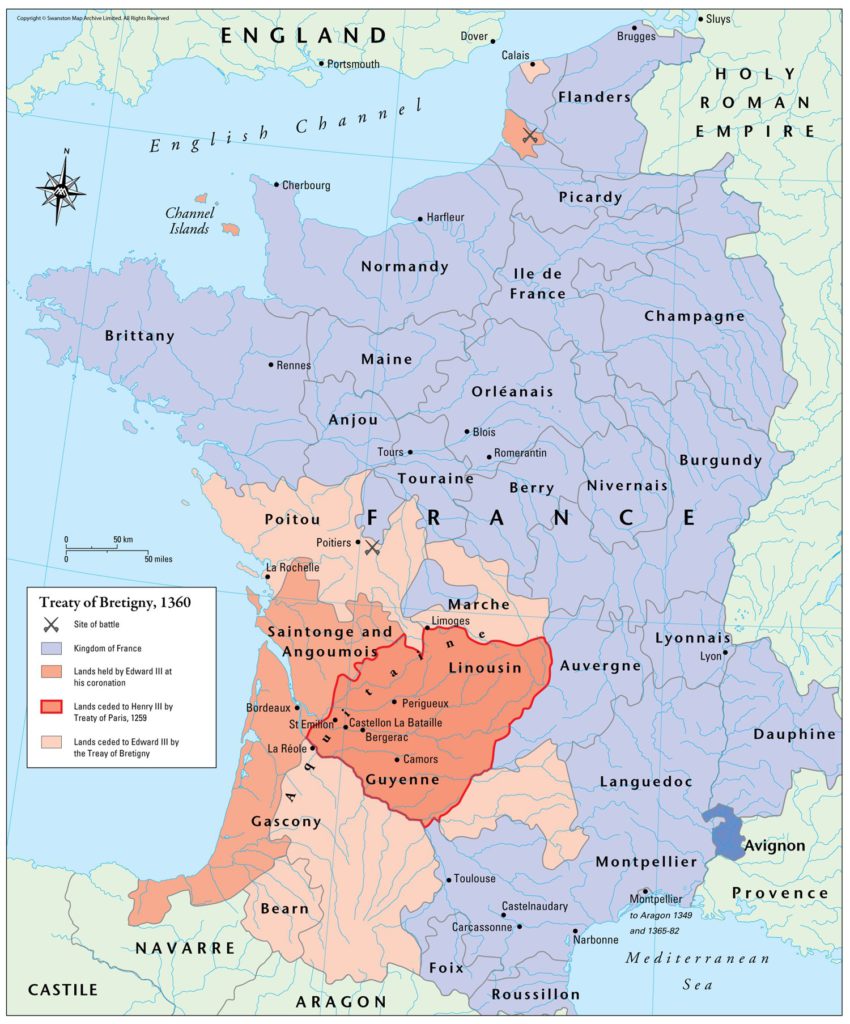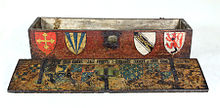On the 24th of October 1360, the Treaty of Brétigny was ratified, marking the end of the first phase of the Hundred Years’ War. This treaty was a sheer calamity for France and a temporary victory for England. This document was drafted on the 8th of May 1360 between King Edward III of England and King Jean II of France known as the Good (le Bon), although this monarch certainly deserves another nickname – perhaps Jean II the Troublemaker (le fauteur de troubles) or the Incompetent (l’incompétent) due to Jean’s lack of personal qualities necessary for a capable ruler. You can read more about Jean II’s merry captivity in England in my another article.
King Jean II of France’s merry captivity in England

In retrospect, we can say that the Treaty of Brétigny embodied the height of English power on the continent. The document was signed at Brétigny, a village near Chartres, and later ratified as the Treaty of Calais. The French bargaining power with the English was rather weak after the disastrous defeat of the Valois armies at the Battle of Poitiers in 1356 when King Jean II of France was taken prisoner by Edward, Prince of Wales known as the Black Prince. This document was signed after Jean had spent 4 years entertaining and relaxing in captivity in England, while his son, Dauphin Charles (future King Charles V of France) had to deal with his rival for the Valois crown – Charles II of Navarre, known as Charles the Bad, as well as with drastic conflicts in Paris between Étienne Marcel and the dauphin, and the outbreak of the Jacquerie (peasant revolt in France).
Why was this treaty extremely bad for the French and extraordinarily beneficial for the English? According to the signed document, King Edward III of England gave up his claim to the Crown of France. Why did the power-hungry Edward act so? He obtained a vast number of lands from the French, including Guyenne, Gascony, Poitou, Saintonge, Périgord, Limousopn, Aunis, Agenais, Quercy, Bigorre, Gauré, Angoumois, Rouergue, Montreuil-sur-Mer, Ponthieu, Calais, Sangatte, Ham, and the countship of Guînes. In general, it was almost 1/3 of the territory of France back then, so Edward had compelling reasons to be exhilarated. Moreover, the ruler of England held these lands free and no longer had to pay homage for the King of France as his overlord. The title Duke of Aquitaine was replaced with Lord of Aquitaine, but these were small changes.
Edward planned that these territories would constitute an expanded version of Aquitaine. A satisfied Edward was ready to make some concessions to the Valois family: he gave up the duchy of Touraine, the countship of Anjou and Maine, the suzerainty of Brittany and of Flanders. The terms of Brétigny were aimed at easing the tension between the two nations and untangling the toxic mixture of feudal relations in these lands. Furthermore, the French had to pay 3 million écus for the ransom of King Jean II, who would be released after the first payment of 1 million. This was an incredible amount of money! It was 5 or 6 times more than England’s annual income, and several times Jean II’s own income, although France was a wealthier country.


Edward III of England attempted to squeeze everything out of France’s coffers he could. At first, Edward demanded the ransom of 5 million écus, but Dauphin Charles negotiated the decrease in the requested amount for his father by 2 million écus. Jean’s 2 sons: Louis I, Duke d’Anjou and Duke Jean de Berry were taken hostage by the English, and many nobles and notable citizens of France had to join them as prisoners. This treaty was sworn to by the two monarchs and by their eldest sons – Edward, the Black Prince and Dauphin Charles. Afterwards Edward III retired to England with triumph that nevertheless proved to be temporary in history.
Jean II of France returned home to raise money for the payment of the rest of his ransom. Jean did not change and ruled with the same arrogance, lack of knowledge in governance, and was unable to extinguish the flames of discontent among the aristocrats and the commoners who had to pay for his freedom. In 1362, Louis d’Anjou, who was held in Calais, escaped, and King Jean considered it necessary to return to England because of what he saw as his son’s “lack of chivalry.” As Jean died in his second captivity, his eldest son was crowned King Charles V of France, and the treaty procured only a 9-year respite from the military conflict. Thanks to Charles V’s intelligence and to the victories of the French under the leadership of Bertrand du Guesclin, the lost territories were restored to the French crown by 1377 when Edward III passed away. The tide of the Hundred Years’ War would turn several times in decades to come.
All images are in the public domain.
Text © 2020 Olivia Longueville






Very informative. Thanks! A very good map indicating the lands Edward III gained. Intrigued by the enclave that was left to the French above Limoges: must check out why.